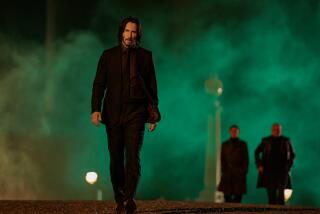Review: Terrence Malick’s ‘Song to Song’ finds beauty, frustration and hope in the Austin music scene

Justin Chang reviews “Song to Song,” written and directed by Terrence Malick, starring Ryan Gosling, Rooney Mara, Michael Fassbender, Natalie Portman and Cate Blanchett. Video by Jason H. Neubert.
- Share via
There comes a moment in “Song to Song,” the latest cinematic symphony written and directed by Terrence Malick, when Ryan Gosling pauses to tell Cate Blanchett, “You’re beautiful.” It’s a supremely redundant statement, this beautiful man telling this beautiful woman how beautiful she is in a movie that, like every Malick enterprise, is a hymn to the beautiful interconnectedness of all things.
Beauty and redundancy have become the defining hallmarks of Malick’s filmmaking, and as long as cinema endures, so will the debate over whether his work deserves our celebration or ridicule. It’s a debate that has only intensified, along with Malick’s output, since the release of his long-gestating, semi-autobiographical 2011 masterwork, “The Tree of Life.”
The intensely personal nature of that film seemed to shake something loose in this famously unhurried director, unleashing a sudden flood of creative activity that produced “To the Wonder” (2012), “Knight of Cups” (2015) and now “Song to Song.” Together, they form a trilogy of contemporary soul-searching that has taken Malick’s interest in visual and narrative fragmentation to startling, sometimes perplexing extremes.
In “Song to Song,” the camera (wielded, as usual, by the great cinematographer Emmanuel Lubezki) alights upon the raucous gatherings and jammed concert stages of the music scene in Austin, Texas. It swoons over glass-walled penthouse apartments and poolside terraces, but seems no less enraptured by the possibilities of a gas station, a parking lot and a South Congress food trailer called Ms P’s. (You may fault Malick’s aesthetics, but I can attest that his taste in fried-chicken joints is impeccable.)
And yet it will surprise no one that Malick, a longtime Austin resident himself, shows no more interest in the specifics of his city’s music-minded enclaves than he did in the creative life of the screenwriter played by Christian Bale in “Knight of Cups.” The snippets of shop talk we hear seem almost willfully trite. Patti Smith turns up as a fount of saintly, weathered wisdom, speaking warmly about her late husband, Fred “Sonic” Smith, but the other artists we see — Iggy Pop and Red Hot Chili Peppers among them — leave merely glancing impressions.
In Malick’s eternally recurring vision of paradise lost, familiar patterns of human behavior — intoxication and disillusionment, seduction and betrayal — will reproduce themselves in any milieu. And so even a place as distinctive as Austin will become a familiar and quintessentially Malickian landscape, where bodies of water ripple calmly at sunset and tall grasses rustle in the breeze. And Malick, not breaking the rules of linear storytelling so much as seeming utterly ignorant of their existence, turns these environments into the staging ground for an intensely stylized human ballet.
The score consists of ambient nature sounds, excerpts from Handel, Debussy and Saint-Saëns, and a few milieu-appropriate blasts of rock ’n’ roll. The principal dancers are Rooney Mara and Gosling as Faye and BV, respectively, two young aspiring musicians who fall deeply in love. The fanciest footwork comes from Michael Fassbender as a lecherous mogul named Cook, the snake slithering around this movie’s grungy-glamorous Eden. He seduces both Faye and BV with promises of success and gestures of affection, but winds up exploiting them both and, eventually, tearing them apart.
Malick, always in thrall to Hollywood actors if not Hollywood methods, does not exactly mean for us to ignore his performers’ celebrity. (Intentionally or not, his choice of talent here evokes movies as different as “Shame,” “Carol” and “La La Land.”) The famous, finely chiseled faces that drift before the camera both fulfill and complicate one of the director’s aims, which is to critique the fleeting temptations and soul-crushing consequences of fame, beauty, power and decadence.
The saddest cautionary tale centers on Rhonda (Natalie Portman), a chipper, church-going waitress who also falls victim to Fassbender’s advances. Amanda (Blanchett) drifts elegantly into BV’s life some time after he and Faye have split up. Faye, for her part, finds herself drawn into an affair with a French beauty named Zoey (Bérénice Marlohe), a Sapphic detour that seems to carry with it a faint but troubling whiff of judgment.
The conservatism of Malick’s worldview is unsurprising, and his protectiveness toward his characters is evident in the time he spends with their concerned parents. (There are at least four of them, played by Linda Emond, Holly Hunter, Brady Coleman and Richard Dillard.) It’s also evident in the way “Song to Song” — a riff on “Song of Songs,” the Old Testament paean to erotic love — seeks to give sexuality a moral and spiritual dimension, to depict the pursuit of pleasure in ways that stir the conscience more than the libido. It’s a moralistic attitude that Malick transforms, through sheer formal intensity, into something almost metaphysical.
What we often see depicted on-screen is not the act of lovemaking itself, but rather an extended pantomime of carnal attraction that feels by turns turbulent, principled and maddeningly coy. The characters tease and kiss, flirt and dance. They wrap themselves in wispy translucent curtains. They unbutton their clothes, suckle each other’s ankles and, in the movie’s signature fetish, lovingly caress the soft flesh of each other’s bellies. (Malick has often been derided as a navel-gazing filmmaker, but this might be the first time I have no choice but to agree.)
This ruptured, convulsive style of image-making may test your patience and frustrate your desire for conventional dramaturgy, but it also gives exquisite visual form to human relationships and states of being that are fundamentally broken and incomplete. Stick with “Song to Song,” and Malick’s elusiveness becomes surprisingly direct. Long, tense conversations are reduced to a few piercing exchanges. Difficult questions and answers are distilled to their philosophical essence. People clash, break apart, fall down, get back up and slowly, tentatively reunite.
“The world wants to be deceived.” “I wished that it could last forever.” “Am I a good person?” “Will you forgive me?” I can’t recall which of these soulful utterances are spoken aloud and which are spoken in voice-over, but for Malick that distinction has almost ceased to matter. No other American filmmaker has gone further to collapse the boundaries between his character’s inner and outer lives or made this level of spiritual inquiry so boldly and movingly central to his art.
To watch “To the Wonder,” “Knight of Cups” and “Song to Song,” in that order, is to finally appreciate the full arc of that inquiry — a fall from grace, a journey through despair and finally a restoration of innocence and hope. It hasn’t been an easy journey, or one immune to the traps of simplification and cliché, but even those pitfalls finally speak to Malick’s deeply moving sense of abandon, his willingness to risk all in the pursuit of a vision of transcendence. The final image we see in “Song to Song” isn’t a tease or a caress, but an embrace — a decisive ending that holds out the possibility of a new beginning.
------------
‘Song to Song’
MPAA rating: R, for some sexuality, nudity, drug use and language
Running time: 2 hours, 9 minutes
Playing: ArcLight Cinemas, Hollywood, and the Landmark Theatre, West Los Angeles
See the most-read stories in Entertainment this hour »
Movie Trailers
More to Read
Only good movies
Get the Indie Focus newsletter, Mark Olsen's weekly guide to the world of cinema.
You may occasionally receive promotional content from the Los Angeles Times.







